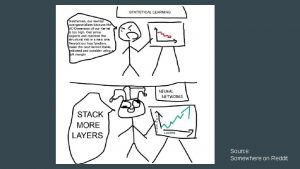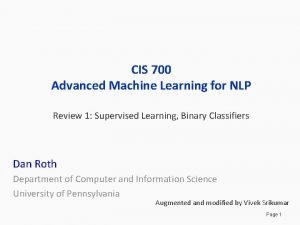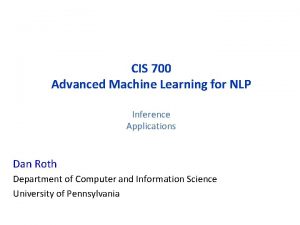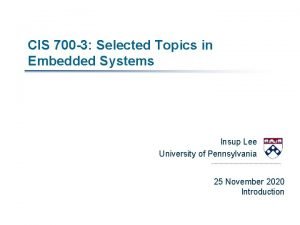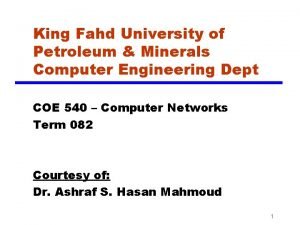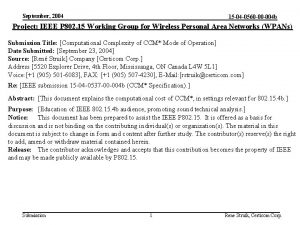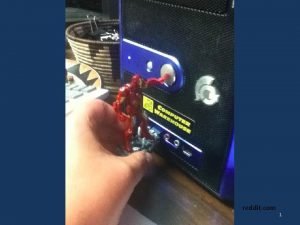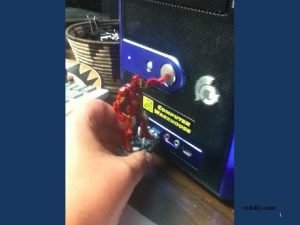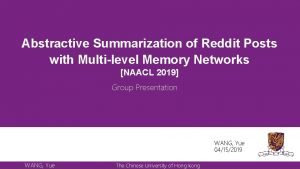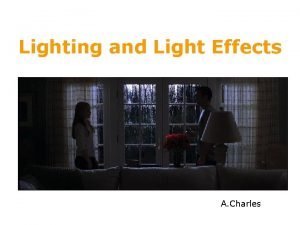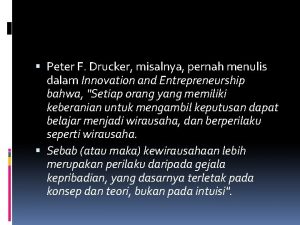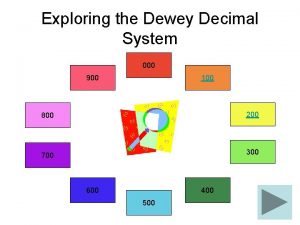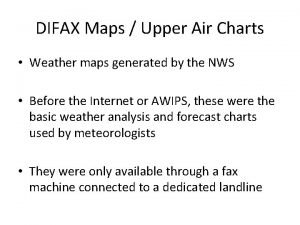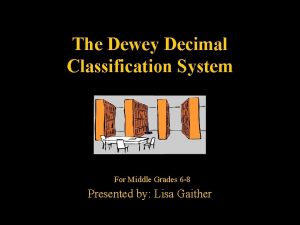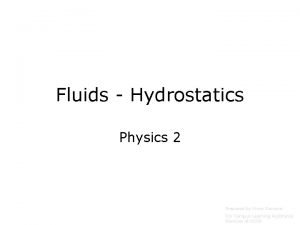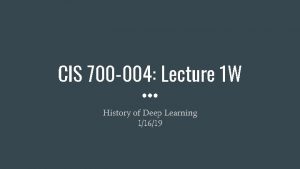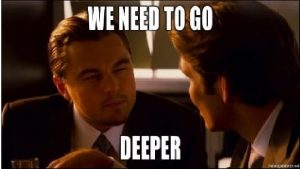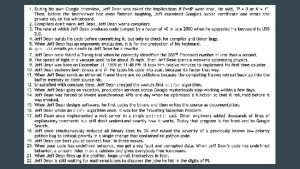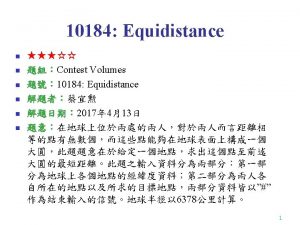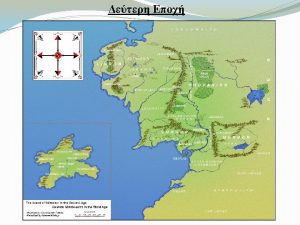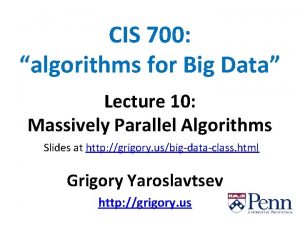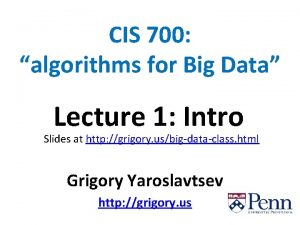Source Somewhere on Reddit CIS 700 004 Lecture




























































- Slides: 60

Source: Somewhere on Reddit

CIS 700 -004: Lecture 3 W Challenges in training neural nets 01/30/19

Course Announcements ● HW 0 is due tonight. ● Reminder to make a private Piazza post if you'd like Canvas access to submit the homework as an auditor. We have 10 additional spots for enrollment available to people who submit the homework.

Today, we pretend to be doctors!

Today's agenda ● Finish up the anatomy of a neural net ○ ○ Loss functions Universal approximation ● Tensorboard: a data scientist's best friend ● Challenges in training neural nets ○ ○ Initialization challenges Gradient challenges ■ Magnitude problems ■ Direction problems

Loss functions

Mean squared error ● Often used if the network is predicting a scalar.

Cross-entropy ● Most common loss function for classification tasks. ● It is a measure of distance between two probability distributions. ● For classification, generally the target vector is one-hot encoded, which means that is 1 where belongs to class j, and is otherwise 0. ● Be careful to apply cross-entropy loss only to probabilities! (e. g. after softmax) ● In Py. Torch, softmax and cross-entropy can be applied in a single step. ● Be careful in that case not to apply it twice : )

Cosine similarity ● Computes similarity between directions of two vectors. ● Often used in NLP contexts. For example, the two vectors might be the frequencies of different words.

Universal Approximation

No Free Lunch Theorem “If an algorithm performs better than random search on some class of problems then in must perform worse than random search on the remaining problems. ” Aka "A superior black-box optimisation strategy is impossible. " Aka "If our feature space is unstructured, we can do no better than random. "

No Free Lunch Theorem

Some problems are harder than others. Linearly separable problems Easy xor Continuous problems Real-life problems Problems with no structure Hard Solved by perceptron Unsolvable by No Free Lunch Theorem

Some problems are harder than others. Linearly separable problems xor Continuous problems Real-life problems Easy Problems with no structure Hard Solved by perceptron Loosely, UAT says that neural nets can solve these problems Unsolvable by No Free Lunch Theorem

Universal Approximation Theorem

Cybenko's construction Suppose we want to approximate the following function: y x

Cybenko's construction Suppose we want to approximate the following function: y 1 2 We can approximate it as a piecewise-constant function. 3 4 x

Cybenko's construction Let's make a neural net that represents the indicator function for the interval [2, 3].

Cybenko's construction: the indicator function

Cybenko's construction Interval a 1 y 1 Σ . . . Interval an yn Indicator approximators y

UAT insight: any nonconstant, bounded, continuous transfer function could generate a class of universal approximators.

Training Challenges

Training Challenges: Initialization

How do we initialize our weights? ● Most models work best when normalized around zero. ● All of our choices of activation functions inflect about zero. ● What is the simplest possible initialization strategy?

Zero initialization ● We set all weights and biases to be zero in every element. ● How will this perform?

Zero initialization: is horrible. Zero initialization Vanilla

Zero initialization: debugging why it's so horrible Outputs

Zero initialization: debugging why it's so horrible Parameters

Zero initialization: debugging why it's so horrible Gradients

Zero initialization gives you an effective layer width of one. Don't use it. Ever.

The next simplest thing: random initialization ● We select all weights and biases uniformly from the interval [0, 1] ● How will this perform?

Random initialization: slightly better. Random initialization Vanilla

Random initialization scales poorly with layers.

Smart initializations ● The variance of a single weight should scale inversely with width. Correction - He et al. : variance = 2/n, not 1/2 n

Xavier initialization: good. Also familiar. Xavier initialization Vanilla

Py. Torch uses Xavier initialization.

Training Challenges: Gradient Flow

Various learning curves demonstrating problems.

Training Challenges: Gradient Magnitude

Rate tuning

Advanced optimizers: Adagrad ● "Adaptive gradient algorithm" ● Adapts a learning rate for each parameter based on size of previous gradients.

Advanced optimizers: RMSprop ● "Root mean square prop" ● Adapts a learning rate for each parameter based on size of previous gradients.

Advanced optimizers: Adam ● "Adaptive moment estimation" ● Similar to RMSprop, but with both the first and second moments of the gradients

What to do when your gradients are still enormous

What to do when your gradients are too small ● ● Find a better activation? Find a better architecture? Find a better initialization? Find a better career?

Training Challenges: Gradient Direction


A brief interlude on algorithms ● A batch algorithm does a computation all in one go given an entire dataset ○ ○ Closed-form solution to linear regression Selection sort Quicksort Pretty much anything involving gradient descent. ● An online algorithm incrementally computes as new data becomes available ○ ○ Heap algorithm for the kth largest element in a stream Perceptron algorithm Insertion sort Greedy algorithms

Minibatching ● A minibatch is a small subset of a large dataset. ● In order to perform gradient descent, we need an accurate measure of the gradient of the loss with respect to the parameters. The best measure is the average gradient over all of the examples (gradient descent is a batch algorithm). ● Computing over 60 K examples on MNIST for a single (extremely accurate) update is stupidly expensive. ● We use minibatches (say, 50 examples) to compute a noisy estimate of the true gradient. The gradient updates are worse, but there are many of them. This converts the neural net training into an online algorithm.

How Py. Torch handles batching # MNIST Dataset dataset = dsets. MNIST(root='. /data', train=True, transform=transforms. To. Tensor(), download=True) # Data Loader (Input Pipeline) data_loader = torch. utils. data. Data. Loader(dataset=dataset, batch_size=100, shuffle=True)

Classical regularization

Dropout

Dropout ● Prevents overfitting by preventing co-adaptations ● Forces "dead branches" to learn ● Developed by Geoffrey Hinton, patented by Google

Dropout

Early stopping* *not built-in. Oh, the horror.

So why do we have all this machinery?

So why is training a deep neural net hard? ● ● Universal approximation theorem doesn't help us learn a good approximator. Neural nets do not have a closed form solution. Neural nets do not have a convex loss function. Neural nets are really expressive.

The awful, awful VC-dimension of neural nets

The optimization problem is hard, and there are no guarantees on learnability. We invented methods for manipulating gradient flow to get good parametrizations despite tricky loss landscapes.

Looking forward ● HW 0 is due tonight. ● HW 1 will be released later this week. ● Next week, we discuss architecture tradeoffs and begin computer vision.
 700 004
700 004 Reddit
Reddit Cis 700
Cis 700 Cis 700
Cis 700 Cis 700
Cis 700 Cis 700
Cis 700 Croix de saint andré charpente métallique
Croix de saint andré charpente métallique Team-004
Team-004 Pyp 004 kfupm
Pyp 004 kfupm 0560 004
0560 004 Auec2-001
Auec2-001 Wer darf behälter freimessen?
Wer darf behälter freimessen? Sol 005
Sol 005 01:640:244 lecture notes - lecture 15: plat, idah, farad
01:640:244 lecture notes - lecture 15: plat, idah, farad Maksim mrvica youtube
Maksim mrvica youtube It's gotta start somewhere it's gotta start sometime
It's gotta start somewhere it's gotta start sometime Somewhere deep in the woods
Somewhere deep in the woods There is always a bull market somewhere
There is always a bull market somewhere Ee cummings somewhere i have never travelled
Ee cummings somewhere i have never travelled If you want to go fast
If you want to go fast Harold arlen somewhere over the rainbow
Harold arlen somewhere over the rainbow The furthest distance ive travelled poem
The furthest distance ive travelled poem Indefinite pronouns cartoon
Indefinite pronouns cartoon Vera lynn somewhere over the rainbow
Vera lynn somewhere over the rainbow Somewhere over the rainbow judy garland
Somewhere over the rainbow judy garland Anywhere any where
Anywhere any where Rainbow tables download
Rainbow tables download In 292
In 292 Reddit
Reddit Horizontal prototype
Horizontal prototype Image -site:reddit.com
Image -site:reddit.com Typeerror: write() argument must be str, not list
Typeerror: write() argument must be str, not list Reddit doctor stories
Reddit doctor stories Image -site:reddit.com
Image -site:reddit.com Pihole best adlist
Pihole best adlist Image -site:reddit.com
Image -site:reddit.com Childfolio teacher
Childfolio teacher Quo vodis
Quo vodis Image -site:reddit.com
Image -site:reddit.com Site: reddit.com
Site: reddit.com Prototype 2 reddit
Prototype 2 reddit Reddit memory test
Reddit memory test Image -site:reddit.com
Image -site:reddit.com Heda symbol
Heda symbol Reddit
Reddit Good grounding
Good grounding Image -site:reddit.com
Image -site:reddit.com Vsfs statement of interest example
Vsfs statement of interest example Wolf
Wolf Rob is your pen friend
Rob is your pen friend Irmgard keun nach mitternacht
Irmgard keun nach mitternacht Dewey decimal 100
Dewey decimal 100 850 mb chart
850 mb chart Vde 0100-700
Vde 0100-700 Dot-sp 15448
Dot-sp 15448 700 ad
700 ad Nearest metre
Nearest metre In situ level troll 700
In situ level troll 700 Dewey decimal system mythology
Dewey decimal system mythology Vrc 700 installation
Vrc 700 installation 700 kg
700 kg

